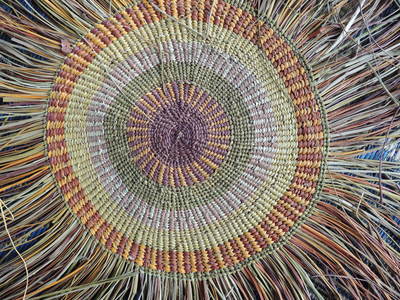Recent News
2019/2020
In 2020, I plan to challenge myself by reinventing my handmade plant paper and exploring using it a more sculptural context . I have only ever used a screen technique I would like to research, experiment and study other methods. I am looking at ways I would be able to study Amante paper making in Mexico.
Although I was very content with the exhibition of Ubiquitous Cocoons and the public reaction to it, I am still exploring ideas around more work related to the cocoon series, the theme of identity, privilege and my relation to nature. I am considering building two more large cocoons similiar to “skin” on the same theme. I would like to figure out something inside one such as the marquette shown here with spruce roots and gut.
What if one opened and covered the ceiling with wings?
2018/ 2019 Ubiquitous Cocoons
I had an exhibition in June 2019 at the Haida Gwaii Museum “ Ubiquitous Cocoons” .
In November I spent 5 days studying with Sculptor Mo Kelman. Her approach to forming skeletons made of various materials covered with different skins - everything from, net, pantyhose to pig gut - opened a new portal for me.
Being granted a BC Arts Council Grant also allowed me to focus full time on all aspects of my work for the exhibition.
2017 India Flint workshop
Having had a lifelong interest in natural textiles I was delighted to attend a Five day workshop by India Flint of Australia using natural plant materials for dyeing without Mordants or chemicals. I was especially interested in dyeing paper.
2016 Marapu N.T. Australia residency immersion Aboriginal weaving and culture
In late July I arrived in Darwin. From Darwin we travelled two full days to Marparu in the Northern Arhem land by road , sleeping on the ground under the stars.
I participated in a 10-day weaving and cultural immersion with three generations of traditional Aboriginal weavers. Their knowledge has been passed down from mother to daughter and granddaughter for generations. Historically, baskets were often the only belongings carrying these peoples’ stories, knowledge, language, law, and even mens and women's power.
I made a twined pandanus dilly bag with Kurranda string. Bark is gathered from the Kurranda tree and twined by rubbing it on your thigh. All the older women have calluses on their thighs.
I also meet with Lindy Allen who specializes in fibre at the Melbourne Museum and was privileged to look through the amazing collection of thousands of baskets they have catalogued.
In 2020, I plan to challenge myself by reinventing my handmade plant paper and exploring using it a more sculptural context . I have only ever used a screen technique I would like to research, experiment and study other methods. I am looking at ways I would be able to study Amante paper making in Mexico.
Although I was very content with the exhibition of Ubiquitous Cocoons and the public reaction to it, I am still exploring ideas around more work related to the cocoon series, the theme of identity, privilege and my relation to nature. I am considering building two more large cocoons similiar to “skin” on the same theme. I would like to figure out something inside one such as the marquette shown here with spruce roots and gut.
What if one opened and covered the ceiling with wings?
2018/ 2019 Ubiquitous Cocoons
I had an exhibition in June 2019 at the Haida Gwaii Museum “ Ubiquitous Cocoons” .
In November I spent 5 days studying with Sculptor Mo Kelman. Her approach to forming skeletons made of various materials covered with different skins - everything from, net, pantyhose to pig gut - opened a new portal for me.
Being granted a BC Arts Council Grant also allowed me to focus full time on all aspects of my work for the exhibition.
2017 India Flint workshop
Having had a lifelong interest in natural textiles I was delighted to attend a Five day workshop by India Flint of Australia using natural plant materials for dyeing without Mordants or chemicals. I was especially interested in dyeing paper.
2016 Marapu N.T. Australia residency immersion Aboriginal weaving and culture
In late July I arrived in Darwin. From Darwin we travelled two full days to Marparu in the Northern Arhem land by road , sleeping on the ground under the stars.
I participated in a 10-day weaving and cultural immersion with three generations of traditional Aboriginal weavers. Their knowledge has been passed down from mother to daughter and granddaughter for generations. Historically, baskets were often the only belongings carrying these peoples’ stories, knowledge, language, law, and even mens and women's power.
I made a twined pandanus dilly bag with Kurranda string. Bark is gathered from the Kurranda tree and twined by rubbing it on your thigh. All the older women have calluses on their thighs.
I also meet with Lindy Allen who specializes in fibre at the Melbourne Museum and was privileged to look through the amazing collection of thousands of baskets they have catalogued.







